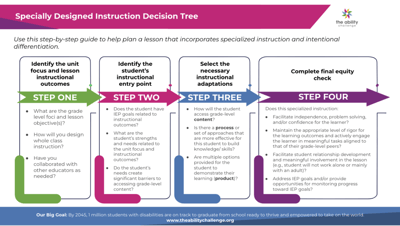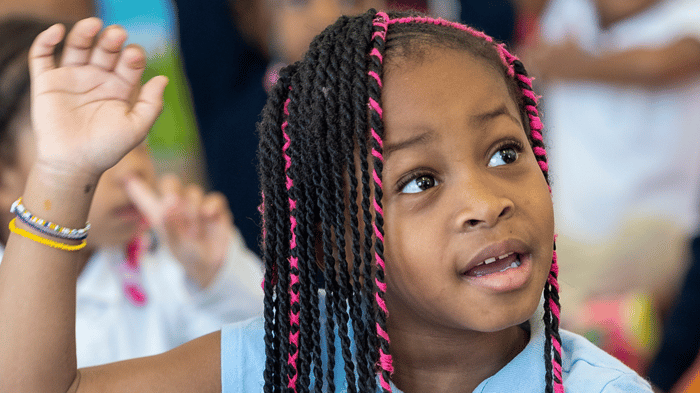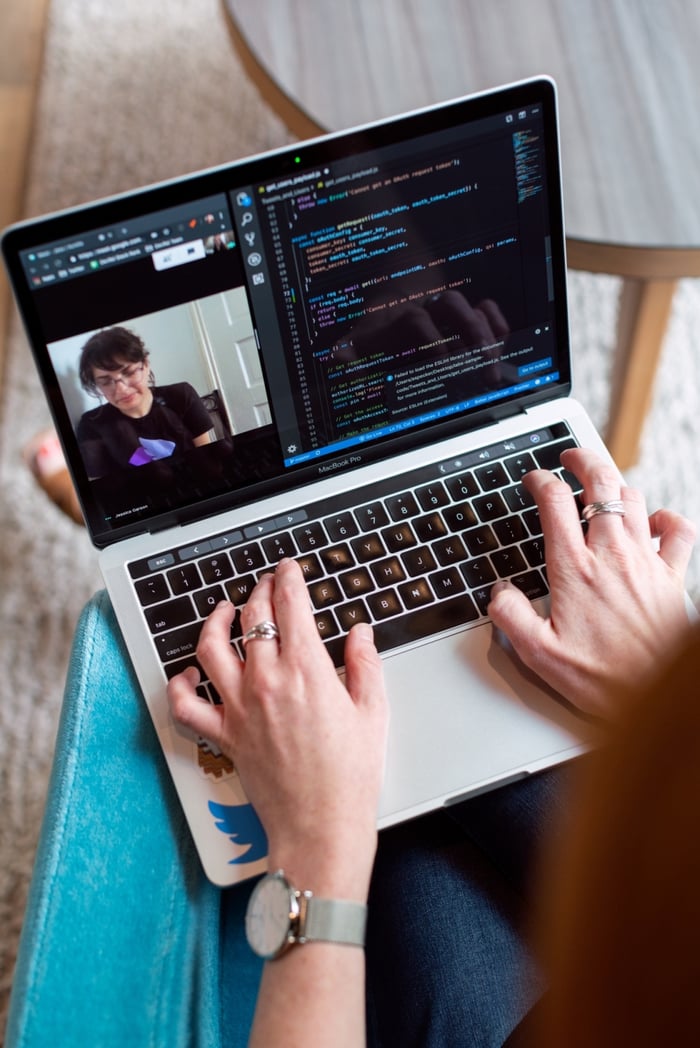Supporting Your Teachers to Design Quality Special Education Instruction
Tools • 6 min read • Oct 13, 2022 10:25:00 PM • Written by: Sarah Sandelius

Overview
School and District leaders can help improve student engagement by working with their teachers to improve how they design instruction to support all learners.
 This decision tree presents everything you need to know in an easy, downloadable tool!
This decision tree presents everything you need to know in an easy, downloadable tool!
As data from the past two years become increasingly available, we’re learning even more about the impact of the pandemic on our students. Studies show that the most diverse learners may have suffered among the most dramatic educational consequences. Before and even after school shutdowns, one truth continues to stand out – understanding how best to support students with unique learning needs, such as students with disabilities, is an area where many educators need more support. Under the law, students with disabilities are entitled to a unique kind of specially designed instruction (SDI) that removes the specific barriers their disability creates to accessing grade-level content. However, how that mandate gets translated into practice continues bewildering the education sector.
At its core, SDI is exceptionally strong teaching that is individualized for different types of learners. The skills and knowledge that special educators use to create dynamic lessons that are accessible to students with disabilities (e.g., understanding the various student needs, designing lessons using many modalities, using flexible groupings and student choice) can also be used by all teachers to meet the needs of all students. We hope this blog can demystify SDI and provide tips for interested leaders.
First, what is SDI?
SDI is defined in the Individuals with Disabilities Education Act (IDEA) as “adapting, as appropriate to the needs of an eligible child under this part, the content, methodology, or delivery of instruction:
- To address the unique needs of the child that result from the child’s disability and
- To ensure access of the child to the general curriculum…”
While SDI shares similarities with other concepts in the realm of specially designed instruction strategies, it's crucial to grasp the nuanced distinctions among these terms.
Universal Design for Learning (UDL) is a broad, proactive approach to designing curricula to be accessible to all students. With UDL, teachers vary the means of engagement, representation, and expression to ensure that instruction is tailored to the different ways brains intake information.
Differentiation, on the other hand, is a more general term and describes a reactive approach to adding support based on the needs of students. According to Carol Ann Tomlinson, “Differentiation means tailoring instruction to meet individual needs. Whether teachers differentiate content, process, products, or the learning environment, the use of ongoing assessment and flexible grouping makes this a successful approach to instruction.”
SDI is accommodated and modified instruction designed for a single student with a disability who requires those adjustments to progress in the general education curriculum (and on the student’s IEP goals).
While these concepts may overlap in implementation, the key to understanding SDI is that it includes strategies and instructional design methods intentionally planned to remove the barriers imposed by a student’s disability to enable them access to the core curriculum.

Why is it important?
More often than not, in the classrooms we visit, teachers have many of the skills needed to help all students learn and thrive. However, in many of those same classrooms, we frequently see lessons being taught in one way to one group of students – and logically so because this is the way most curricula are written. Teaching to the middle is also smart when you are strapped for time, overwhelmed by work, and not given enough time to collaborate with peers. And yet, this approach overlooks the long-term gains of engaging those students at the margins. Turning to SDI to provide content differently depending on the students in your class will help them connect with the same learning opportunities other students may have.
Effective SDI is both a skill and a mindset. It requires teachers to fundamentally believe that students with disabilities can learn just as much as their peers and to know how to drill into what a student needs to access the content.
How is SDI done well?
Three categories help guide effective instructional design when planning for SDI: Content, Process, and Product. In some instances, there is a fourth category – environment (e.g., adjusting the physical setting in which learning occurs).
Category One – Content
In sporadic cases (<10% of students), SDI can include modifications to what content a student is learning. It’s important to understand that most students (>90% of students with disabilities) will not require changes to what is being taught and will be able to access grade-level content with accommodations to process or product successfully. Modifying content unnecessarily (which happens all too frequently) often leads to significant gaps in learning and substantially disparate long-term outcomes.
Category Two – Process
In most cases, SDI is about adjusting how teaching is done so students learn the same material as their peers. Process accommodations include using graphic organizers with prompts, audiobooks, breaking down assignments into parts, adjusting pacing, or giving students choices about completing a particular activity. This is where strategic lesson design can be quite effective – if you are clear about what you are trying to teach and how you know a student has learned it, you can be creative about getting the student to that goal.
Category Three – Product
Product accommodations vary the means of assessing for understanding such that the product of the teaching enables a student to show how much they know. These can vary from enabling the student to choose how they demonstrate knowledge to using a very structured closed approach to assessment and everything in between. This type of design should be used when the check for understanding and the disability-related barriers intersect. For example, for a student who struggles with reading, one may choose to forgo a history quiz that is heavily reading-based and instead assess knowledge by giving students the choice between an oral presentation, an artistic representation, or a multimedia deliverable.
The Bottom Line
Excellent, specially designed instruction is planned for a particular student and their needs but can be made available for (and beneficial to) all students to support them with understanding content.
Here are some last helpful tips for you as you plan Specially Designed Instruction:
Start with core content – If you know what you want to teach and how you plan to teach it, you’ll be well-positioned to identify access points for different learners. Understanding what a student can do to learn a new skill can often serve as a guidepost for what needs to be accommodated.
Focus on student needs – SDI doesn’t require new skills beyond what is needed for effective instruction. The key is using disability-related clues to hone in on specific student needs and the possible barriers/opportunities those needs may present.
Always keep equity in mind – Grade-level, standards-aligned content is usually the end goal, and all SDI must be reasonably calculated for a student to make adequate progress.
Want to Learn More About the Decision Tree Tool?
Watch our Office Hours video for an overview of specially designed instruction and our Decision Tree Tool.
Gain Even More Insight by Offering Your Educators Engaging Professional Learning
Lessons that Engage: Designing Instruction to Meet the Needs of Diverse Learners is a full-day professional learning course designed to provide educators with a foundational understanding of differentiating lessons to engage students with disabilities. Educators will learn how to plan for different types of learners and will be introduced to a decision-making process and planning tool for specializing instruction during a facilitated planning session.
Click here for a course overview.
Ready to Make an Impact For Your Most Diverse Learners?
Sarah Sandelius
Our Latest
Related Articles

May 13, 2024 | Administrators
Intervention: Have We Gone Too Far?
Is your school overreliant on intervention? Learn how to support diverse learners, including student...

March 26, 2020 | Tools
Ten Ideas for Keeping Students with Diverse Learning Needs Engaged At Home
Master the challenges of remote instruction with expert tips on diverse learning. Adapt to this new ...

January 12, 2021 | Culture of Inclusion
5 Steps to Building More Collaborative, Equitable, and Inclusive Classrooms
Learn about an innovative approach to foster collaboration among educators and enhance inclusive cla...

